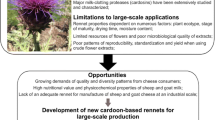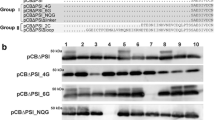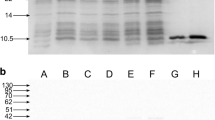Abstract
Different sheep and goat cheeses with world-renowned excellence are produced using aqueous extracts of Cynara cardunculus flowers as coagulants. However, the use of this vegetable rennet is mostly limited to artisanal scale production, and no effective solutions to large-scale industrial applications have been reported so far. In this sense, the development of a synthetic rennet based on the most abundant cardoon milk-clotting enzymes (cardosins) would emerge as a solution for scalability of production and for application of these proteases as alternative rennets in dairy industry. In this work, we report the development of a new cardosin B-derived rennet produced in the generally regarded as safe (GRAS) yeast Kluyveromyces lactis. Using a stepwise optimization strategy—consisting of culture media screening, complemented with a protein engineering approach with removal of the plant-specific domain, and a codon optimization step—we successfully improved cardosin B production yield (35×) in K. lactis. We demonstrated that the secreted enzyme displays similar proteolytic properties, such as casein digestion profiles as well as optimum pH (pH 4.5) and temperature (40 °C), with those of native cardosin B. From this optimization process resulted the rennet preparation Vegetable Rennet (VRen), requiring no downstream protein purification steps. The effectiveness of VRen in cheese production was demonstrated by manufacturing sheep, goat, and cow cheeses. Interestingly, the use of VRen resulted in a higher cheese yield for all three types of cheese when compared with synthetic chymosin. Altogether, these results clearly position VRen as an alternative/innovative coagulant for the cheese-making industry.







Similar content being viewed by others
References
Agboola S, Chen S, Zhao JZ (2004) Formation of bitter peptides during ripening of ovine milk cheese made with different coagulants. Lait 84:567–578
Asakura T, Matsumoto I, Funaki J, Arai S, Abe K (2000) The plant aspartic proteinase-specific polypeptide insert is not directly related to the activity of oryzasin 1. Eur J Biochem 267:5115–5122
Castanheira P, Samyn B, Sergeant K, Clemente JC, Dunn BM, Pires E, Van Beeumen J, Faro C (2005) Activation, proteolytic processing, and peptide specificity of recombinant cardosin A. J Biol Chem 280:13047–13054
Celik E, Calık P (2012) Production of recombinant proteins by yeast cells. Biotechnol Adv 30:1108–1118
Cordeiro MC, Xue ZT, Pietrzak M, Pais MS, Brodelius PE (1994) Isolation and characterization of a cDNA from flowers of Cynara cardunculus encoding cyprosin (an aspartic proteinase) and its use to study the organ-specific expression of cyprosin. Plant Mol Biol 24:733–741
da Costa DS, Pereira S, Moore I, Pissarra J (2010) Dissecting cardosin B trafficking pathways in heterologous systems. Planta 232:1517–1530
da Costa DS, Pereira S, Pissarra J (2011) The heterologous systems in the study of cardosin B trafficking pathways. Plant Signal Behav 6:895–897
Dunn BM (2002) Structure and mechanism of the pepsin-like family of aspartic peptidases. Chem Rev 102:4431–4458
Dutt K, Gupta P, Saran S, Misra S, Saxena RK (2009) Production of milk-clotting protease from Bacillus subtilis. Appl Biochem Biotechnol 158:761–772
Egas C, Lavoura N, Resende R, Brito RM, Pires E, de Lima MC, Faro C (2000) The saposin-like domain of the plant aspartic proteinase precursor is a potent inducer of vesicle leakage. J Biol Chem 275:38190–38196
Egito AS, Girardet J, Laguna L, Poirson C, Molle D, Miclo L, Humbert G, Gaillard J (2007) Milk-clotting activity of enzyme extracts from sunflower and albizia seeds and specific hydrolysis of bovine κ-casein. Int Dairy J 17:816–825
Esteves CL, Lucey JA, Pires EM (2001) Mathematical modelling of the formation of rennet-induced gels by plant coagulants and chymosin. J Dairy Res 68:499–510
Esteves CL, Lucey JA, Wang T, Pires EM (2003) Effect of pH on the gelation properties of skim milk gels made from plant coagulants and chymosin. J Dairy Sci 86:2558–2567
Faro CM, Moir AJG, Pires E (1992) Specificity of milk clotting enzyme extracted from the thistle Cynara cardunculus L.: action on oxidized insulin and k-casein. Biotechnol Lett 14:841–846
Figueiredo RD, Duarte P, Pereira S, Pissarra J (2006) The embryo sac of Cynara cardunculus: ultrastructure of the development and localisation of the aspartic proteinase cardosin B. Sex Plant Reprod 19:93–101
Frazao C, Bento I, Costa J, Soares CM, Verissimo P, Faro C, Pires E, Cooper J, Carrondo MA (1999) Crystal structure of cardosin A, a glycosylated and Arg-Gly-Asp-containing aspartic proteinase from the flowers of Cynara cardunculus L. J Biol Chem 274:27694–27701
Guiama VD, Libouga DG, Ngah E, Beka RG, Ndi KC, Malonga B, Bindzi JM, Donn P, Mbofung CM (2010) Milk-clotting potential of fruit extracts from Solanum esculentum, Solanum macrocarpon L. and Solanum. J Biotechnol 9:1797–1802
Johnson ME, Lucey JA (2006) Major technological advances and trends in cheese. J Dairy Sci 89:1174–1178
Kappeler SR, van den Brink HJ, Rahbek-Nielsen H, Farah Z, Puhan Z, Hansen EB, Johansen E (2006) Characterization of recombinant camel chymosin reveals superior properties for the coagulation of bovine and camel milk. Biochem Biophys Res Commun 342:647–654
Khan AR, Khazanovich-Bernstein N, Bergmann EM, James MN (1999) Structural aspects of activation pathways of aspartic protease zymogens and viral 3C protease precursors. Proc Natl Acad Sci U S A 96:10968–10975
Koelsch G, Mares M, Metcalf P, Fusek M (1994) Multiple functions of pro-parts of aspartic proteinase zymogens. FEBS Lett 343:6–10
Kumar A, Sharma J, Mohanty AK, Grover S, Batish VK (2006) Purification and characterization of milk clotting enzyme from goat (Capra hircus). Comp Biochem Physiol B Biochem Mol Biol 145:108–113
Kumar A, Grover S, Sharma J, Batish VK (2010) Chymosin and other milk coagulants: sources and biotechnological interventions. Crit Rev Biotechnol 30:243–258
Lucey JA (2002) ADSA Foundation Scholar Award. Formation and physical properties of milk protein gels. J Dairy Sci 85:281–294
Lucey JA, Johnson ME, Horne DS (2003) Invited review: perspectives on the basis of the rheology and texture properties of cheese. J Dairy Sci 86:2725–2743
Lufrano D, Faro R, Castanheira P, Parisi G, Verissimo P, Vairo-Cavalli S, Simoes I, Faro C (2012) Molecular cloning and characterization of procirsin, an active aspartic protease precursor from Cirsium vulgare (Asteraceae). Phytochemistry 81:7–18
Macedo AC, Malcata FX, Oliveira JC (1993) The technology, chemistry, and microbiology of Serra cheese: a review 1. J Dairy Sci 76:1725–1739
Macedo IQ, Faro CJ, Pires EM (1996) Caseinolytic specificity of cardosin, an aspartic protease from the cardoon Cynara cardunculus L.: action on bovine αs- and β-casein and comparison with chymosin. J Agric Food Chem 44:42–47
Marck C, Grosjean H (2002) tRNomics: analysis of tRNA genes from 50 genomes of Eukarya, Archaea, and Bacteria reveals anticodon-sparing strategies and domain-specific features. RNA 8:1189–1232
Martins APL, Vasconcelos MMPD, Sousas RBD (1996) Thistle (Cynara cardunculus L) flower as a coagulant agent for cheesemaking. Short characterization. Lait 76:473–477
Menzella HG (2011) Comparison of two codon optimization strategies to enhance recombinant protein production in Escherichia coli. Microb Cell Factories 10:2–8
Merico A, Capitanio D, Vigentini I, Ranzi BM, Compagno C (2004) How physiological and cultural conditions influence heterologous protein production in Kluyveromyces lactis. J Biotechnol 109:139–146
Mohanty AK, Mukhopadhyay UK, Kaushik JK, Grover S, Batish VK (2003) Isolation, purification and characterization of chymosin from riverine buffalo (Bubalos bubalis). J Dairy Res 70:37–43
Néstor G-M, Rubí C-GD, Héctor J-C (2012) Exploring the milk-clotting properties of a plant coagulant from the berries of S. elaeagnifolium var. Cavanilles. J Food Sci 77:C89–C94
Pimentel C, Van Der Straeten D, Pires E, Faro C, Rodrigues-Pousada C (2007) Characterization and expression analysis of the aspartic protease gene family of Cynara cardunculus L. FEBS J 274:2523–2539
Raimondi S, Uccelletti D, Amaretti A, Leonardi A, Palleschi C, Rossi M (2010) Secretion of Kluyveromyces lactis Cu/Zn SOD: strategies for enhanced production. Appl Microbiol Biotechnol 86:871–878
Ramalho-Santos M, Verissimo P, Faro C, Pires E (1996) Action on bovine alpha s1-casein of cardosins A and B, aspartic proteinases from the flowers of the cardoon Cynara cardunculus L. Biochim Biophys Acta 1297:83–89
Ramalho-Santos M, Pissarra J, Verissimo P, Pereira S, Salema R, Pires E, Faro CJ (1997) Cardosin A, an abundant aspartic proteinase, accumulates in protein storage vacuoles in the stigmatic papillae of Cynara cardunculus L. Planta 203:204–212
Ramalho-Santos M, Pissarra J, Pires E, Faro C (1998) Cardosinogen A. The precursor form of the major aspartic proteinase from cardoon. Adv Exp Med Biol 436:253–258
Reis PJM, Malcata FX (2011) Current state of Portuguese dairy products from ovine and caprine milks. Small Rumin Res 101:122–133
Rogelj I, Perko B, Francky A, Penca V, Pungercar J (2001) Recombinant lamb chymosin as an alternative coagulating enzyme in cheese production. J Dairy Sci 84:1020–1026
Roseiro LB, Barbosa M, Ames JM, Wilbey RA (2003a) Cheesemaking with vegetable coagulants - the use of Cynara L. for the production of ovine milk cheeses. Int J Dairy Technol 56:76–85
Roseiro LB, Ilbey RAW, Arbosa MB (2003b) Serpa cheese: technological, biochemical and microbiological characterisation of a PDO ewe’s milk cheese coagulated with Cynara cardunculus L. Lait 83
Sarmento AC, Lopes H, Oliveira CS, Vitorino R, Samyn B, Sergeant K, Debyser G, Van Beeumen J, Domingues P, Amado F, Pires E, Domingues MR, Barros MT (2009) Multiplicity of aspartic proteinases from Cynara cardunculus L. Planta 230:429–439
Schmidt FR (2004) Recombinant expression systems in the pharmaceutical industry. Appl Microbiol Biotechnol 65:363–372
Shieh C-J, Phan Thi L-A, Shih I-L (2009) Milk-clotting enzymes produced by culture of Bacillus subtilis natto. Biochem Eng J 43:85–91
Silva SV, Malcata FX (1999) On the activity and specificity of cardosin B, a plant proteinase, on ovine caseins. Food Chem Toxicol 67:373–378
Silva SV, Malcata FX (2000) Action of cardosin A from Cynara humilis on ovine and caprine caseinates. J Dairy Res 67:449–454
Silva SV, Malcata FX (2005) Partial identification of water-soluble peptides released at early stages of proteolysis in sterilized ovine cheese-like systems: influence of type of coagulant and starter. J Dairy Sci 88:1947–1954
Silva SV, Xavier Malcata F (1998) Proteolysis of ovine caseins by cardosin A, an aspartic acid proteinase from Cynara cardunculus L. Lait 78:513–519
Silva SV, Allmere T, Xavier Malcata F, Andrén A (2003) Comparative studies on the gelling properties of cardosins extracted from Cynara cardunculus and chymosin on cow's skim milk. Int Dairy J 13:559–564
Simoes I, Faro C (2004) Structure and function of plant aspartic proteinases. Eur J Biochem 271:2067–2075
Simoes I, Mueller EC, Otto A, Bur D, Cheung AY, Faro C, Pires E (2005) Molecular analysis of the interaction between cardosin A and phospholipase D(alpha). Identification of RGD/KGE sequences as binding motifs for C2 domains. FEBS J 272:5786–5798
Sousa MM, Malcata F (1997) Comparison of plant and animal rennets in terms of microbiological, chemical, and proteolysis characteristics of ovine cheese. J Agric Food Chem 45:74–81
Sousa MJ, Malcata FX (2002) Advances in the role of a plant coagulant (Cynara cardunculus) in vitro and during ripening of cheeses from several milk species. Lait 82:151–170
Terauchi K, Asakura T, Ueda H, Tamura T, Tamura K, Matsumoto I, Misaka T, Hara-Nishimura I, Abe K (2006) Plant-specific insertions in the soybean aspartic proteinases, soyAP1 and soyAP2, perform different functions of vacuolar targeting. J Plant Physiol 163:856–862
Tormakangas K, Hadlington JL, Pimpl P, Hillmer S, Brandizzi F, Teeri TH, Denecke J (2001) A vacuolar sorting domain may also influence the way in which proteins leave the endoplasmic reticulum. Plant Cell 13:2021–2032
Ustunol Z, Hicks CL (1990) Effect of milk-clotting enzymes on cheese yield. J Dairy Sci 73:8–16
van den Berg JA, van der Laken KJ, van Ooyen AJ, Renniers TC, Rietveld K, Schaap A, Brake AJ, Bishop RJ, Schultz K, Moyer D, Richman M, Shuster J (1990) Kluyveromyces as a host for heterologous gene expression: expression and secretion of prochymosin. Biotechnology (N Y) 8:135–139
van Ooyen AJ, Dekker P, Huang M, Olsthoorn MM, Jacobs DI, Colussi PA, Taron CH (2006) Heterologous protein production in the yeast Kluyveromyces lactis. FEMS Yeast Res 6:381–392
Varani G, McClain WH (2000) The G x U wobble base pair. A fundamental building block of RNA structure crucial to RNA function in diverse biological systems. EMBO Rep 1:18–23
Verissimo P, Esteves C, Faro C, Pires E (1995) The vegetable rennet of Cynara cardunculus L. contains two proteinases with chymsin and pepsin-like specificities. Biotechnol Lett 17:621–626
Verissimo P, Faro C, Moir AJ, Lin Y, Tang J, Pires E (1996) Purification, characterization and partial amino acid sequencing of two new aspartic proteinases from fresh flowers of Cynara cardunculus L. Eur J Biochem 235:762–768
Vieira M, Pissarr J, Verissimo P, Castanheira P, Costa Y, Pires E, Faro C (2001) Molecular cloning and characterization of cDNA encoding cardosin B, an aspartic proteinase accumulating extracellularly in the transmitting tissue of Cynara cardunculus L. Plant Mol Biol 45:529–539
White PC, Cordeiro MC, Arnold D, Brodelius PE, Kay J (1999) Processing, activity, and inhibition of recombinant cyprosin, an aspartic proteinase from cardoon (Cynara cardunculus). J Biol Chem 274:16685–16693
Yegin S, Fernandez-Lahore M, Jose Gama Salgado A, Guvenc U, Goksungur Y, Tari C (2011) Aspartic proteinases from Mucor spp. in cheese manufacturing. Appl Microbiol Biotechnol 89:949–960
Acknowledgments
This work was funded by Fundo Europeu de Desenvolvimento Regional (FEDER) Funds through the Operational Competitiveness Programme (COMPETE) by National Funds through the Fundação para a Ciência e a Tecnologia (FCT) under the project PTDC/AGR-ALI/102540/. Authors would like to acknowledge grant PEst-C/SAU/LA0001/2013-2014.
Author information
Authors and Affiliations
Corresponding author
Rights and permissions
About this article
Cite this article
Almeida, C.M., Gomes, D., Faro, C. et al. Engineering a cardosin B-derived rennet for sheep and goat cheese manufacture. Appl Microbiol Biotechnol 99, 269–281 (2015). https://doi.org/10.1007/s00253-014-5902-5
Received:
Revised:
Accepted:
Published:
Issue Date:
DOI: https://doi.org/10.1007/s00253-014-5902-5




